1991 Belgian Grand Prix
Surprise, surprise
A quick look at the results of the Belgian Grand Prix might give the impression that the McLaren-Honda team monopolised the event and dominated the opposition, but it would be very far from the truth. Admittedly they finished first and second, with Ayrton Senna leading Gerhard Berger home by a comfortable two seconds, but the clue to the truth lies in the fact that Roberto Moreno set fastest lap in the race on lap 40, at which point Senna was holding a precarious lead over de Cesaris, in a Jordan-Cosworth, with gearbox trouble that was making him wonder if he was going to finish the 44-lap race, and Berger was fourth with little hope of improving his position. Moreno was running sixth and finished fourth entirely due to other people’s troubles. The whole Belgian Grand Prix was fraught with the unexpected.
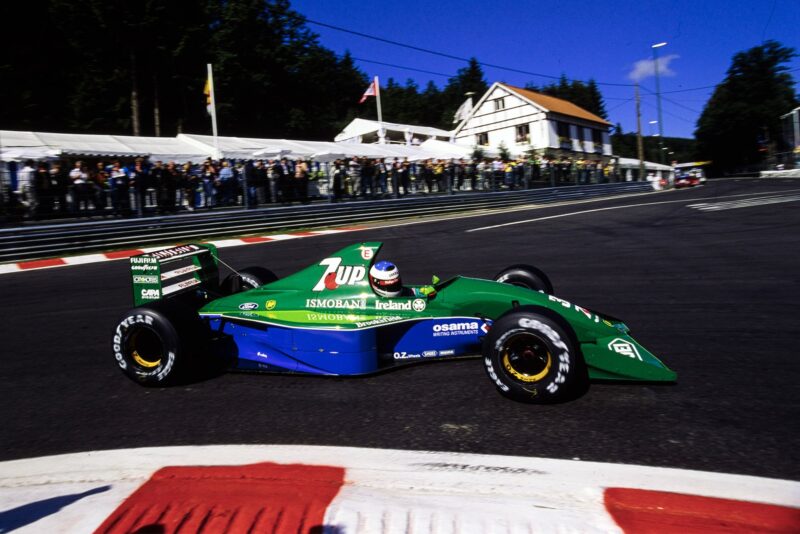
Michael Schumacher in the Jordan 191 on his debut weekend in F1
Motorsport Images
The unexpected appeared even before practice began, for Bertrand Gachot found himself locked away in Brixton prison for unruly and unlawful behaviour after a minor traffic incident. (Did I say he knew where he was going, in last month’s Motor Sport ?)
His place in the Jordan team was taken by the 22 year-old Michael Schumacher, on loan from the Mercedes-Benz sports car team, and his uninhibited performance was one of the highlights of the two days of practice and qualifying. Not surprisingly Senna was fastest on both days, taking pole position with a lap in 1 min 47.811 sec, over a second quicker than the next man. If Senna was not the fastest round the magnificent Spa-Francorchamps circuit, with its challenging length of nearly seven kilometres containing everything from a hairpin bend to 170mph corners and a straight-line maximum of 197mph, there would be something very wrong with the state of Grand Prix racing. To be fastest he naturally needs the full support of McLaren, Honda, Goodyear and Shell who all do their part in the equation of speed and performance.
Honda were not their usual reliable self, though the V12 was performing adequately, but it was also giving major troubles due to being run very close to the limit and a major blow-up on Berger’s car in the second qualifying session prevented him from improving on his Friday time. That was only good for fifth place on the grid, but a last-minute decision by the stewards of the meeting promoted him up to fourth place and a lot of other drivers moved up a place as well. The cause of this change was Patrese’s Williams-Renault being found during post-practice scrutineering to have an inoperative reverse gear, which is totally against the known rules. He had been in great form and had qualified faster than Mansell and was only beaten by Senna. The stewards decreed that Patrese should forfeit all his Saturday lap times, which left him with his Friday lap time which was only good enough for 17th place on the grid, and Prost was promoted to second place alongside Senna.
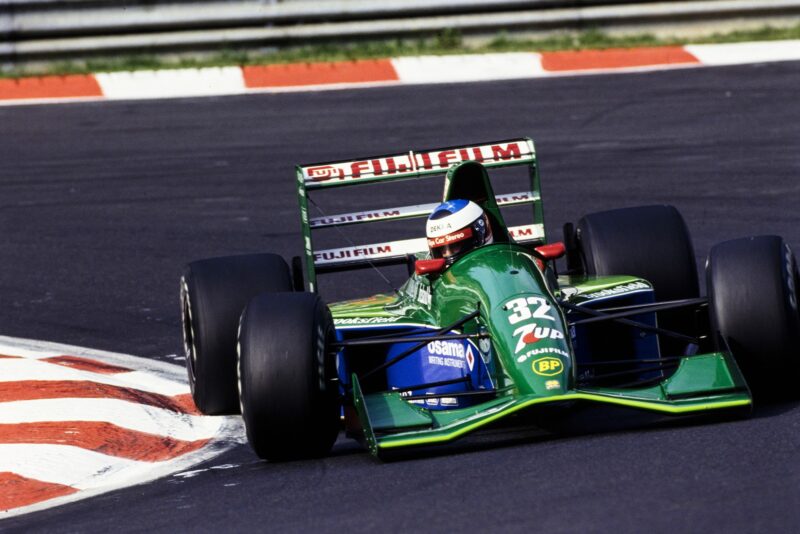
The German would be forced out of the race early on but impressed many in the paddock
Motorsport Images
There was a lot of fluttering in the media dovecote over the performances by the new young German driver Schumacher, and his eighth place in the qualifying times (promoted to seventh later) was the sort of thing that made one sit up and take notice and personally prompted me to journey out to the far end of the circuit to get an idea of how it was achieved. What I saw was similar to the occasion when Jean Alesi first appeared in a Tyrrell 019. Here was a man making the car do what he wanted, when he wanted it, not hanging on to see what the car wanted to do, and this was on a 120mph blind downhill left-hander. Ignoring Patrese’s disqualification, the only drivers faster than Schumacher were Senna, Patrese, Prost, Mansell, Berger, Alesi and Piquet and that needs no further comment. Andrea de Cesaris has been showing us that there is not much wrong with the Jordan car for quite a time, at least with its 585bhp Cosworth engine; how it would be with 800bhp might be another matter.
Within seconds of the green starting light flashing on the German ‘wonder-boy’ was out of the race, not due to somebody else’s mistake going into the first corner, but because of destroying his clutch on his first attempt at a racing start with a fully-laden car. Those people spectating beyond the first corner never did see the star of qualifying; all the media euphoria died away and the world’s press had to watch the boring spectacle of Ayrton Senna driving away into the lead, followed by Prost (Ferrari), Mansell (Williams), Piquet (Benetton), Berger (McLaren) and Alesi (Ferrari). However, the unexpected was not far away, for on lap two Mansell overtook Prost and on lap three the leading Ferrari was gone! Smoke and flames came from the engine compartment and a very disgruntled Prost was out of the race, but he was not alone for Gugelmin had already retired with smoke and steam, hot water and oil coming out of the engine of his Leyton House.
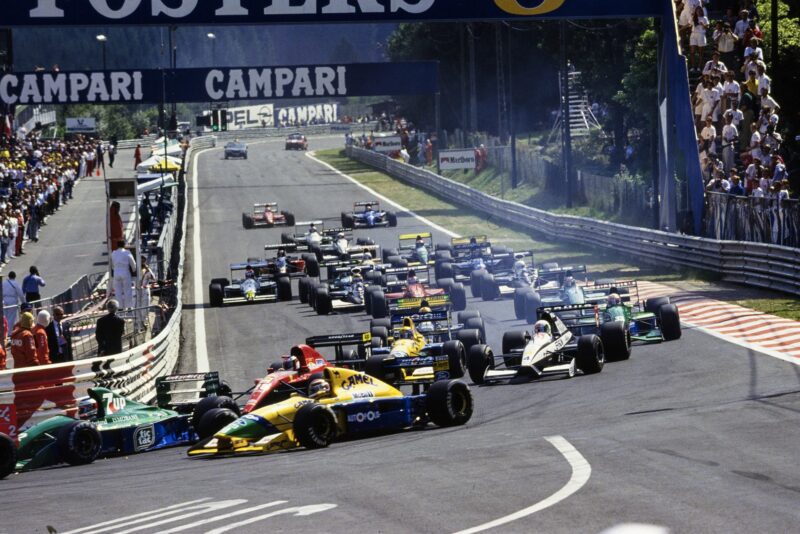
The start of the Belgian Grand Prix as the drivers head into La Source
Motorsport Images
By the end of lap three Senna and Mansell were out on their own, the Brazilian clearly letting Mansell set the pace but staying ahead without too much effort. The pace was depressingly slow by comparison with qualifying speeds, the McLaren and the Williams lapping in lm 58secs to 1m 59secs, some 12 seconds slower than what we had witnessed the day before. The last qualifier on the grid had been Erik Comas (Ligier-Lamborghini) with a best time of 1m 53.847 sec, and now we had the leaders circulating in 1min 58secs, but it was a lovely sunny afternoon, the circuit was on its best behaviour and all was well with the world, so we could sit back and enjoy it even though the adrenalin was only simmering; the V12 Honda and the V10 Renault were singing their songs of power as they took the steep hill at Eau Rouge, and continued on full song all the way up to Les Combes. There was always the unexpected that might disturb the peace of the afternoon.
Being behind Senna, and quite close at times, is one thing; being in front is something different altogether. For 14 laps Senna and Mansell were out on their own, but then on consecutive laps they came into the pits for a routine tyre stop and the Williams team won the pit-stop competition in no uncertain manner. Senna was delayed a number of seconds by a wheel nut baulking when being replaced, whereas Mansell’s stop was perfection so the outcome was that he now led the race comfortably. Alesi was planning to take his Ferrari through without a tyre change, starting the race on a harder compound tyre, and it was paying off because he was in second place, between Mansell and Senna.
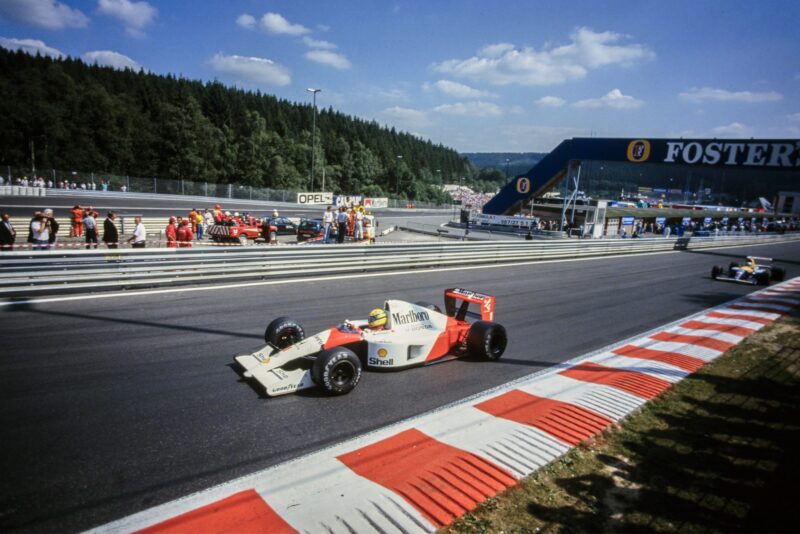
Ayrton Senna leads Nigel Mansell
Motorsport Images
Outwardly it looked as if the fumbled McLaren pit stop had not only lost their man the lead, but possibly second place as well, for Senna did not seem overanxious to make up any ground on Alesi’s Ferrari. What we did not know was that Senna had decided that he was not going to be able to do much about Mansell’s commanding lead, the Williams-Renault being more than a match for the McLaren-Honda on performance, and Alesi’s second place was not secure because if he was going through non-stop his tyres were going to be very worn in the closing stages of the race, added to which Senna could see tell-tale whiffs of smoke coming from the Ferrari exhaust pipes.
Hardly had this situation stabilised than Mansell rounded La Source hairpin with his Renault engine losing power dramatically and he pulled off at the foot of the hill at Eau Rouge with the engine popping and banging but running as flat as a pancake. Something very important was completely out of kilter and his race was run. This left Alesi in the lead with Senna in second place. Four laps after Mansell’s retirement, Senna came down the hill from La Source at 100mph instead of his normal 170mph and crept up the hill (relatively) and went out of sight seemingly stuck in the wrong gear. A Ferrari victory began to look a possibility, but Senna re-appeared next lap going at his normal speed and there was just time to speculate on what was happening in the McLaren when Alesi’s Ferrari came down the hill a lap or two later and a huge spume of oil smoke erupted from the engine compartment the young Frenchman’s moments of glory in the lead of the Belgian Grand Prix were over.
Senna was back in the lead but was having problems with his gearbox and, after some careful experimenting, he had decided to run the rest of the race using only fourth, fifth and sixth gears, the only doubtful point being rounding La Source hairpin in fourth, but he quickly adapted to that. All this unexpected excitement at the front of the race completely overshadowed what was going on down through the field. Very unexpectedly there was now a bright green Jordan running in second place, having led Berger’s McLaren for quite a time, mostly due to the Austrian having a bad pit-stop for tyres, and then spinning completely round as he booted it out of the pit exit road! Almost overlooked was Patrese’s climb up from his 17th place on the starting grid to a very praiseworthy fourth, but the Jordan not only passed the Williams but then went after Piquet’s Benetton which was in third. Just as Alesi’s Ferrari blew up the Jordan passed Piquet into third place, which promptly became second. One could be forgiven for thinking it was the German ‘wonder boy’, but it wasn’t, it was de Cesaris! Did I say this race was full of the unexpected?
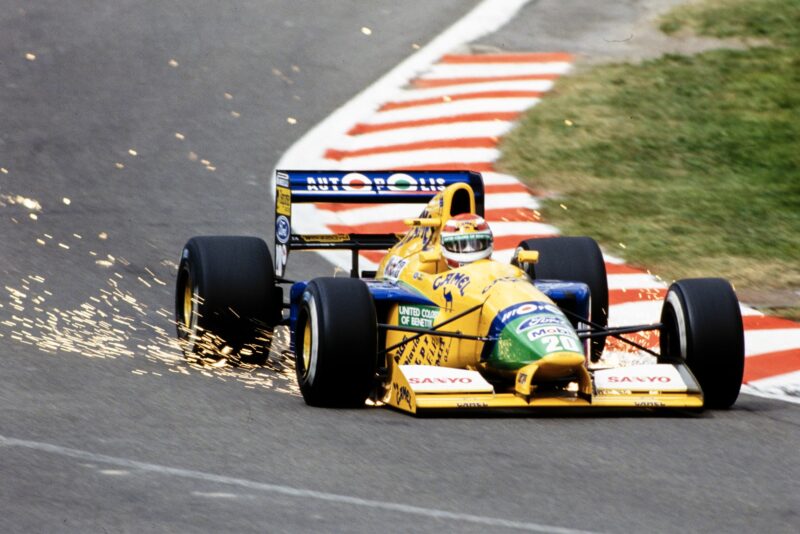
Nelson Piquet in his Benetton
Motorsport Images
For 10 glorious laps the experienced, but short on results, Italian driver looked as though he was going to put his name in the Golden Book of results, but it was not to be; on lap 42 the Cosworth engine failed and the valiant little green car was out of the race only three laps from the finish. If de Cesaris was in tears, who could blame him? The Jordan team was distraught because at this time of the year, when serious plans for next season are being negotiated in darkened motorhomes, a second place at Spa-Francorchamps is as good a visiting card as anyone could wish for.
Senna was in full command of the lead, in spite of his gearbox problem, but Berger had now moved up into second place as Patrese slowed dramatically with his Williams-Renault stuck in fifth gear, and Piquet was fast running out of usable rubber on his Pirelli tyres and could offer no challenge. On the last lap as Senna approached the finish to win his fourth Belgian Grand Prix on a circuit that is ‘Grand Prix’ rather than a ‘Formula One Facility’, Moreno passed the unfortunate Patrese, who had suffered a miserable weekend through no fault of his own. In sixth place, and just in the all-important points chase, was Mark Blundell with the Brabham-Yamaha V12. — DSJ
***
Results (top five), Belgian GP, Spa Francorchamps, August 25
44 laps of 6.94 km circuit (305.360 km; 189.741 miles)
1. Ayrton Senna, BRA, (McLaren MP4/6 – Honda V12) 1h 27m 17.669s
2. Gerhard Berger, AUT, (McLaren MP4/6 – Honda V12) 1h 27m 19.570s
3. Nelson Piquet, BRA, (Benetton B191 – Cosworth V8 EXP) 1h 27m 49.845s
4. Roberto Moreno, BRA, (Benetton B191 – Cosworth V8 EXP) 1h 27m 54.979s
5. Riccardo Patrese, I, (Williams FW14 – Renault V10) 1h 28m 14.856s
Conditions: Hot
Winner’s Average Speed: 209.883 kph (130.415 mph)
Fastest lap: Roberto Moreno (Benetton B191 – Cosworth V8 EXP) 1m 55.161s on lap 40; 216.948 kph (134.806 mph)
